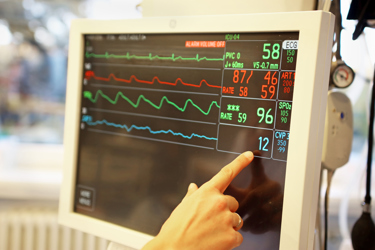Remote Photonic Radar System Can Accurately Monitor Breathing

By John Oncea, Editor

Scientists at Sydney Nano and the School of Physics have developed a photonic radar system capable of delivering contactless, high-definition detection of vital signs. This technology has the potential to be utilized in intensive care units and nursing homes, and for individuals who suffer from sleep apnea or babies with breathing difficulties.
The main function of the respiratory system is gas exchange with oxygen transferred from the external ambient into our bloodstream and carbon dioxide is expelled outside. According to the National Library of Medicine (NLM), “When inhaling, the air flow passes through the larynx and the trachea, and then splits into two bronchi. Each bronchus is divided into two smaller branches to form bronchial tubes. These tubes form a multitude of pathways within the lung that terminate at the end with a link to the alveoli.
“Gases exchanges occur at the alveoli, where oxygen diffuses into the lung capillaries in exchange with carbon dioxide. Exhalation starts after the gas exchange and the air containing carbon dioxide begins to return across the bronchial pathways back out to the external ambient through the nose or mouth.”
The respiratory rate (RR) is the number of breaths a person takes per minute, indicating the air movement in and out of their lungs. A change in RR is usually the first indication of health deterioration, as the body tries to ensure an adequate supply of oxygen to the tissues. Therefore, it is crucial to accurately measure RR during vital signs monitoring.
Measuring RR has historically been done via contact and wearable sensors which, however, are unsuitable for patients with burn wounds or infants with insufficient areas for attachment according to Nature Photonics. In these instances, contactless detection can be achieved using camera imaging, but this method is susceptible to ambient light conditions and comes with privacy concerns.
The solution to all of these problems may be, according to the University of Sydney, a photonic radar system developed by scientists at Sydney Nano Institute and the NSW Smart Sensing Network that delivers contactless, high-definition detection of vital signs.
Measuring RR
Several respiratory monitoring techniques can be classified as contact or remote (non-contact). Contact respiratory devices have direct contact with the patient’s body and are based on measuring one of the following parameters: respiratory sound, respiratory airflow, and respiratory-related chest, or abdominal movements. These include sound-based respiratory monitoring, airflow sensing-based respiratory monitoring, and chest movement-based respiratory monitoring.
Non-contact monitoring techniques measure RR without making contact with the subject’s body and may be more suitable in some critical settings. Types of non-contact monitoring include camera-based respiratory monitoring (both infrared and video-based), radar-based respiratory monitoring, and ultrasound-based.
“Each method offers some advantages and also suffers from some limitations,” notes NLM. “Non-contact monitoring techniques … allow remote breathing detection, which results in improved patient’s comfort compared to contact methods in which the patient is tied to a piece of equipment. These methods, however, require a complex and static setup in addition to their susceptibility to target movements (artifacts), which affects the monitoring accuracy.
“On the other hand, sound detection-based breathing monitoring allows a wearable solution, in which the breathing signal could be measured without restricting the patient’s motion. However, the measured sound signal is highly susceptible to noise either from the surroundings or from other body voices, including talking, coughing, and heartbeats.”
Photonic Radar To The Rescue
Photonic radar can achieve millimeter-level range resolution based on synthesized radar signals with a bandwidth of up to 30 GHz, notes Nature Photonics. The high resolution of the radar system enables accurate respiratory detection from breathing simulators and a cane toad as a human proxy.
In addition, the system proposed can generate optical signals that allow for vital sign detection using light detection and ranging (LiDAR) technology. This demonstration showcases how a sensor-fusion architecture can merge the unique qualities of radar and LiDAR, resulting in enhanced sensing accuracy and system resilience. This serves as a technical foundation for contactless and high-resolution vital sign detection, which is necessary to meet the growing needs of medical and healthcare applications in the future.
The researchers utilized their recently developed and patented radar system to monitor cane toads, successfully detecting pauses in breathing patterns from a remote location. Additionally, they evaluated the system on devices that mimic human breathing to prove its effectiveness. Scientists believe this technology could be used to monitor the vital signs of multiple patients from a single, centralized station, making it a valuable proof of principle for photonic radar.
University of Sydney Pro-Vice-Chancellor (Research) and research lead Professor Ben Eggleton said, “Our guiding principle here is to overcome comfort and privacy issues while delivering highly accurate vital sign monitoring.”
Lead author Ziqian Zhang, a Ph.D. student in the School of Physics, added, “Photonic radar uses a light-based, photonics system – rather than traditional electronics – to generate, collect and process the radar signals. This approach allows for very wideband generation of radio frequency (RF) signals, offering highly precise and simultaneous, multiple tracking of subjects.
“Our system combined this approach with LiDAR – light detection and ranging. This hybrid approach delivered a vital sign detection system with a resolution down to six millimeters with micrometer-level accuracy. This is suitable for clinical environments.”
The researchers hope their discovery will provide a platform to develop a cost-effective, high-resolution, and rapid-response vital sign monitoring system with application in hospitals and corrective services. Their next step is to miniaturize the system and integrate it into photonic chips that could be used in handheld devices.
